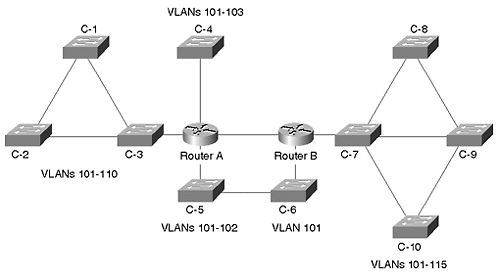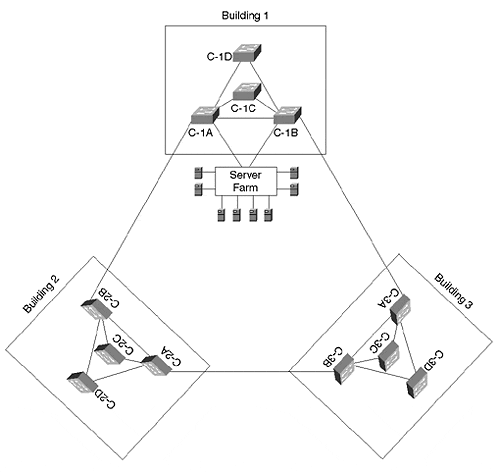Exercises
This section includes a variety of questions and hands-on lab exercises. By completing these you can test your mastery of the material included in this chapter as well as help prepare yourself for the CCIE written and lab tests.
Review Questions
1:
Label the port types (RP=Root Port, DP=Designated Port, NDP=non-Designated Port) and the STP states (F=Forwarding, B=Blocking) in Figure 7-30. The Bridge IDs are labeled. All links are Fast Ethernet. Assume that there is only a single VLAN and that the portvlanpri command has not been used.
Figure 7-30. Two Back-to-Back Catalysts with Crossed Links

When do bridges generate Configuration BPDUs?
3:When do bridges generate Topology Change Notification BPDUs?
4:How many Spanning Tree domains are shown in Figure 7-31? Assume that all of the switches are using ISL trunks and PVST Spanning Tree.
Figure 7-31. Multiple Spanning Tree Domains

When is the Root Bridge placement form of STP load balancing most effective? What command(s) are used to implement this approach?
6:When is the Port Priority form of STP load balancing useful? What command(s) are used to implement this approach? What makes this technique so confusing?
7:When is the Bridge Priority form of STP load balancing useful? What command(s) are used to implement this approach? What makes this technique so confusing?
8:When is the portvlancost form of load balancing useful? What is the full syntax of the portvlancost command? What is the one confusing aspect of this technique?
9:What technology should be used in place of portvlanpri?
10:What are the components that the default value of Max Age is designed to account for? There is no need to specify the exact formula, just the major components captured in the formula.
11:What are the components that the default value of Forwarding Delay is designed to account for? There is no need to specify the exact formula, just the major components captured in the formula.
12:What are the main considerations when lowering the Hello Time from the default of two seconds to one second?
13:Where should PortFast be utilized? What does it change about the STP algorithm?
14:Where should UplinkFast be utilized? In addition to altering the local bridging table to reflect the new Root Port after a failover situation, what other issue must UplinkFast address?
15:Where should BackboneFast be utilized?
16:Where is PVST+ useful?
17:Can MST regions be connected to PVST regions?
18:Can you disable STP on a per-port basis?
19:Why is it important to use a separate management VLAN?
20:What happens if UplinkFast sends the fake multicast frames to the usual Cisco multicast address of 01-00-0C-CC-CC-CC?
Hands-On Lab
Complete an STP design for the network shown in Figure 7-32.
Figure 7-32. A Three-Building Campus Design

Figure 7-32 shows a three-building campus. Each building contains two MDF switches (A and B) and two IDF switches (C and D). The number of IDF switches in each building is expected to grow dramatically in the near future. The server farm has its own switch that connects to Cat-1A and Cat-1B. The network contains 20 VLANs. Assume that each server can be connected to a single VLAN (for example, the SAP server can be connected to the Finance VLAN). Assume that all links are Fast Ethernet except the ring of links between the MDF switches, which are Gigabit Ethernet.
Be sure to address the following items: STP timers, Root Bridges, Load Balancing, failover performance, and traffic flows. Diagram the primary and backup topologies for your design.
Note
This design utilizes what Chapters 14 and 15 refer to as the campus-wide VLANs design model. In general, this design is not recommended for large campus designs. However, it is used here because it makes extensive use of the Spanning-Tree Protocol. For more information on campus-wide VLANs and other design alternatives, please consult Chapters 11, 14, 15, and 17.
EAN: N/A
Pages: 223